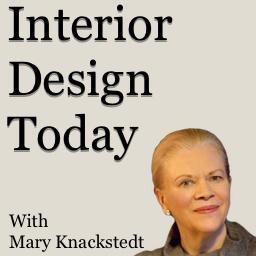Welcome to the Interior Design Today radio show with Mary Knackstedt.
In our 25th episode, Mary talks about bathrooms.
How many bathrooms do you have in your house? At one time, we thought it was wonderful to have one, maybe one and a powder room. Today, it is not unusual to see everyone having their own bathroom plus a few extras. What do these bathrooms look like? Right now I am working on one that is quite small. It is fascinating how the various people who are supplying the components are saying, "this is really tight, this is really small." No wonder because the one we did last week was 15 x 20. Many of them are even larger than that. Some of them are larger than the master bedroom, the living room, or even the dining room.
It is amazing what people are putting into their bathrooms today. We did one a while back where the people had a party when they finished their bathroom. They filled the bathtub with ice and served champagne in the bathroom. I guess we can have parties in our bathrooms...
We are now learning that bathrooms are something that are really designed to fit us individually. They're designed for our size and our special needs. This person wants 8 or 9 shower heads. Another person, a Japanese soaking tub. What type of materials are we using? Amazing, amazing materials. I'm also concerned about safety every time I work on a bathroom. At one time, we always did a large master bathroom, but now in most cases, when we do a master bedroom, we'll do a his and a her bathroom. Perhaps they have their own sinks and share a shower or tub. In other cases, if one has a strong preference for a shower or a tub, they may have their own bathrooms.
People ask about resale. Nobody is worried about that much today. They're worried about what they want. What is convenient for me? What suits me? Am I tall, do I want a higher counter? Am I short, do I want it lower? Do I want a shower that I walk right into so that I don't stub my toe? Good ideas. Of course, we put benches in some showers. We might want a steam shower, this is ever so popular. Every time you add a certain element, it requires other supportive materials. It is amazing to see the types of fans or exhaust systems that are appropriate for bathrooms that have steam showers. After all, if you're producing all that steam, where does it go? We don't want it creating mold or other problems in other parts of the house, so we must be sure that it is properly exhausted.
Just in these few minutes, look at all the elements we've talked about. Look at all the variables. Everything from the water type and sources that we're using. In the house that I live in, the water heater's in the basement and the shower is on the third floor. I can tell you that it takes a long time for the water to get warm in the morning. We no longer do that. We often put the water heater close to the shower, saving water and giving instant hot water for the shower. We no longer have to wait 7-10 minutes for the water to get warm.
Think of all these little elements that we're dealing with, whether water, lighting, surfaces of our floor, grade and draining, etc... The technicalities that are now part of just a regular residential bathroom... No wonder we have specialists. No wonder we are looking for how we can do this the right way, not just the way a contractor has done the last few. You're different. You have different views, wants, and requirements. We need to consider those.
It is so much fun when we do bathrooms for children. What a different type of environment. This can be great fun and be so adaptable to the young children, yet it will grow with them as they mature. Look at your bathroom, is it really giving you the function and the pleasure that you want? Is this one of the rooms that you go to when you want to retreat, relax, or renew? How are you using your bathroom, and what can be done by simple changes or by major ones, to make it more effective for you?
We have all types of opportunities in each and every aspect. Sometimes we're incorporating beautiful pieces of furniture. Other times, it's a mastery system of lighting. All the elements that are now part of this beautiful environment. This lovely music that you hear. The sounds that are stimulating and awaken you in the morning or those that quiet you down at night. Make your bathroom that special place that you can hardly wait to enjoy and you enjoy with great pleasure.
Please subscribe to the video or audio version of the radio show via iTunes or listen to it at http://interiordesigntodaypodcast.blogger.com via the following
MP3 Link.
